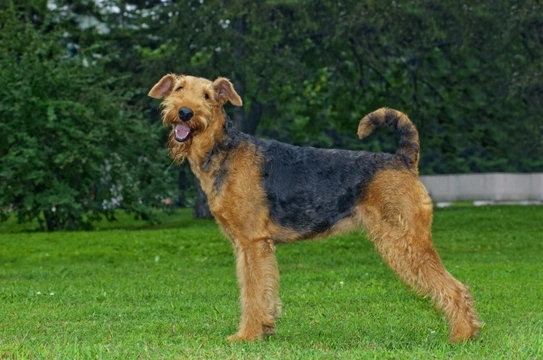
Five interesting facts about the Airedale terrier
The Airedale terrier is one of the UK’s home-grown terrier breeds, but one of the ones that we don’t tend to see as commonly as other types, and they are also distinctive as they are much larger than most other terriers, leading to their unofficial title of “the king of terriers.”
Like most terriers, they are lively, intelligent, outgoing and bold, and they have a strong following of dedicated fans that will tell you that their dogs are the best in the world! If you love the main terrier traits but are looking for a rather larger dog than most terrier breeds, the Airedale might well be the right choice of dog for you.
Before making a commitment to buy or adopt any breed of dog it is of course essential to do lots of research to ensure that the Airedale is the right choice for you, and that you can cater for all of their needs, and fit them in comfortably with your lifestyle.
In this article, we will share five interesting facts about the Airedale terrier that you might not already know, to give you a few insights into the breed, their origins, and what it is like to live with them. Read on to learn more.
They are the largest of the terrier breeds
As mentioned, the Airedale terrier is the largest of all of the terrier breeds, and they are classed as medium to large dogs, with males standing up to 61cm high at the withers, and females a little shorter.
However, they are not particularly heavy for their heights, having a proportionate appearance and lots of lean muscle rather than bulk. They are long legged and can get up a good lick of speed, and they are also quite nimble on their feet and are able to make sharp turns on the fly without losing their footing.
They have worked in a lot of different roles
The Airedale terrier has great skills as a ratter and for other pest control purposes, and they are very tenacious when they catch a scent or spot something that attracts their attention! The wedge-shaped head of the breed and the thick, curled feathering on their chins helps to protect them from rodent bites when they take on prey, and this, combined with their fearless natures and reluctance to lose a hunt when they get the scent, can make them very formidable.
Additionally, the Airedale terrier was one of the first breeds of dog used for police work, and they also assisted the British military during World War 1, where they were put to work as courier dogs and sentries, to alert the soldiers of a hidden approach.
Their hardiness, intelligence, tenacity and general versatility mean that they are viable choices for all sorts of different roles and canine sports.
They are generally good to train and manage
The Airedale terrier has an above average intelligence, which is part of what makes them so useful and versatile for working roles and spots-and they are also generally very pleasant to train, which is not always the case with the very smartest dog breeds.
They are keen to please, adaptive and love learning new skills, and they also have a higher attention span than most dogs, and take well to intensive, fun reward-based training. However, their tenacity can make it hard to keep and retain their attention if they spot something else that catches their eye, and so training the Airedale means ensuring that what you have to offer is always more interesting than the alternatives!
They have a strong prey drive
Like most terrier breeds and particularly those that have a working history as ratters, the Airedale terrier has a strong prey drive and they will often pursue smaller prey such as rabbits when out and about. This can make them a threat to small domestic pets and cats, and so the Airedale owner must take the appropriate steps to ensure that their dogs are supervised, kept under control and prevented from pursuing smaller animals.
While no dog will exhibit 100% reliable recall all the time, working to ensure that the Airedale will come when called even if this means leaving a chase is important, and something that you will continually need to work on.
They are notably good with children
Some terrier breeds are not hugely tolerant of children, particularly young, noisy ones that might not respect the dog’ personal space. However, the Airedale is one terrier breed that is particularly noted as being good with kids, and they are generally calm, tolerant and kind with them, even when young.
They also love playing with children and so, a lively home with a family that likes to spend a lot of time outside taking part in activities that the dog can enjoy too is often a good fit.



